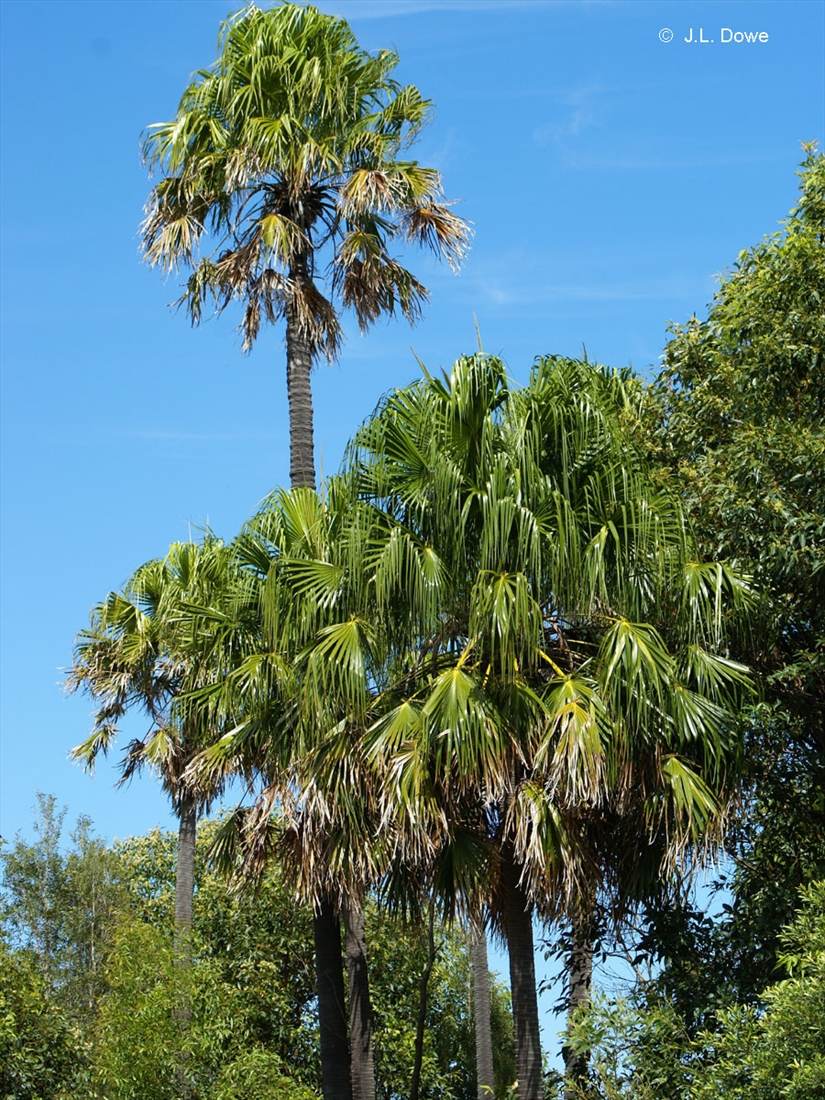Australian Tropical Rainforest Plants - Online edition
Livistona australis (R.Br.) Mart.





Martius, C.F.P. von in Martius, C.F.P. von, Mohl, H. von, & Unger F.J.A. (1838) Historia Naturalis Palmarum 3: 241.
Fan Palm; Cabbage Palm
Trunk solitary, to c. 25 m high, 25-35 cm diameter at 1 m above ground, broadening close to ground into a gently flared cone to c. 50 cm diameter, reducing upward for 5-7 m to a final 20-25 cm diameter. Surface rough but very regularly patterned, prickly with protruding fibres, with strongly stepped sheath scars; vertical fissures usually closely spaced, often branching, deep and gaping, often with criss-crossing fibres showing within. Plants functionally male or female.
Crown moderately compact to rather open, ± rounded, consisting of 35-60 leaves with straight to gently arching or moderately drooping petioles and pendulous segment-lobes. Ligules moderately prominent, pale brown, patchily floccose with ± appressed scales, margins irregularly fimbriate with fine, soft, straight, tapering scales 8-10 mm long. Petiole 140-250 x 1-2 cm; concave-convex to roughly semi-circular, sometimes convex above and often with 1-2 median ridges. Margins unarmed except at base or with a few small, pungent, hooked prickles near apex and scattered minute, blunt teeth elsewhere; toward base armed with ± closely and regularly spaced pungent, mostly retrorsely hooked blackish prickles to 2.5 mm long. Surfaces green, purplish-brown toward base; upper quite glabrous, sometimes irregularly pitted with narrow, elongated pits, lower rather closely pitted with obscure, shallow, short and broad to long and narrow pits, on young leaves bearing floccose scales to 3-4 mm long, usually pale brown, divided to base into several straplike but usually tightly twisted, branched laciniae. Hastula cylindrical to flattened; base shortly but broadly 3-lobed, lateral lobes wider than central; rim at 10-90° to costa, 5-30 mm wide usually with blunt peak at centre, with very narrow to broad necrotic margin. Lamina 110-130 cm long, moderately costapalmate, usually with narrow basal sinus or even with lower edges overlapping, chartaceous-coriaceous, moderately tough to rather brittle and readily split. Segments (35-) 40-46 either side of costa; largest segments 28-49 mm wide, tapering slightly toward point of bifurcation, free for 49-59% of their length, bifurcated for 50-63% of free length, the lobes parallel or slightly diverging, evenly tapering into soft, acute apices, early-frequently broken or split. Major longitudinal veins 7-10 either side of abaxial rib, moderately prominent above, slightly less prominent below; transverse veins evident to moderately prominent above, prominent below. Surfaces green, glossy, often with strong brownish tinge above, deep green beneath, closely striate between veins, quite glabrous except for ribs minutely punctate with brownish, pustular basal-masses, these stipitate on minute prickle-like stalks on adaxial ribs close to hastula; on young leaves bearing dense, floccose, pale brownish scales toward bases of ribs.
Inflorescences mostly shorter than petioles, occasionally equalling them. Partial inflorescences 6-9, subequal, the largest slightly over half total inflorescence length but with strongly recurving branches; rachillae 5-25 cm long and 0.7-0.9 mm thick, white when fresh, glabrous, minutely warty, wrinkled-striate when dry. Rachis bracts flattened-cylindrical, 4-5 cm diameter, often wrinkled, very tough, whitish to pale purplish-brown when fresh; ± striate, sparsely to densely floccose-scaly, especially toward apex, scales usually pale brown, divided into several twisted, branched laciniae to 7 mm long; bract apices triangular, acute or slightly acuminate. Flower-clusters 0.5-3 mm apart, 1-4-flowered; cluster axis 0.5-2.0 (-3.0) mm long; longer cluster axes often with lateral flowers closer to base than apex. Cluster-bract 0.5-1.0 mm long, triangular-ovate, acute or sometimes rather jagged, appressed, membranous. Bracteoles 1 per flower or sometimes an extra one present on 1-flowered clusters, similar to cluster-bract but shorter, mucronate. Flowers 2.5-3.5 mm long, broadly funnel-shaped to rotate. Sepals 1.2-2.1 mm long, fused for half to less of their length with very broad shallow sinuses, closely appressed to petals, moderately concave, membranous apically, fairly tough, broadly to narrowly triangular, subacute to acute. Petals 1.8-3.3 mm long, fused for 0.4-0.8 mm, thick-textured, narrowly triangular to broadly oblong-ovate, bluntly acute to mucronate or almost rounded with thickened, sometimes hooded apex; auriculate at base; inner faces with 3 distinct, broad but rather shallow cavities. Stamens shorter than petals, fused for ¼- their length; filaments thick and fleshy, broadly to narrowly triangular-ovate, hardlyshouldered, tapering smoothly to somewhat abruptly into a slender subulate apex. Ovaries cylindrical to ovoid to obovoid and strongly gibbous apically, gradually to abruptly contracting into styles, 0.2-0.4 mm long.
Fruit spherical, often slightly flattened ventrally, 13-22 mm diameter; suture often faintly visible. Epicarp deep reddish-brown to black, or black with brownish ‘cheek’, dull or with subdued satiny sheen, minutely verruculose and with sparsely and irregularly scattered pale brown circular spots 0.2-0.8 mm diameter often with central pore. Mesocarp 2-3 mm thick, olive green, firmly fleshy and hardly juicy when fresh; sparse thin fibres present, sometimes only adjacent to endocarp. Endocarp 0.2-0.3 mm thick, straw-coloured to pale brown, flexible but rather weak, mostly adhering to mesocarp; both inner and outer surfaces smooth but very minutely rough with loose spicular or papillose surface cells. Seed 11-16 mm diameter; surface pale brown, minutely rough and porous.
Features not available.
The base of the young shoots eaten.





